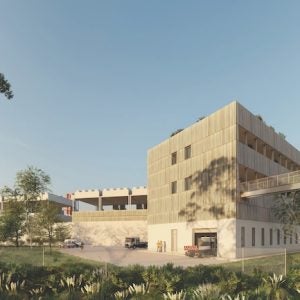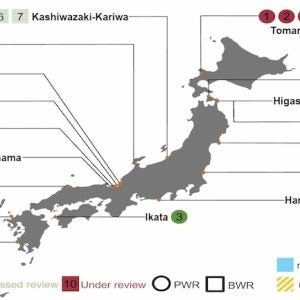The McIntosh site of municipal utility Lakeland Electric (formerly City of Lakeland Department of Electricity and Water Utilities) has a commendable track record when it comes to the pioneering of innovative approaches to coal power generation. But the site, in Polk County, Florida, is now also hosting a key project in the development of gas turbine and combined cycle technologies.
It is here, at McIntosh unit 5, that the first Siemens Westinghouse W501G gas turbine has been installed. This gas turbine was synchronised with the grid for the first time on 21 April 1999, having left the Siemens Westinghouse manufacturing facility in Hamilton, Ontario, Canada, at the end of October 1998. The unit remains in prototype testing mode, which it combines with concurrently serving the peaking needs of the utility.
So far the gas turbine has been running as a simple cycle unit with a nominal rating of 249 MW, and has achieved 288 MW at colder ambient. Emissions and performance testing have been successfully completed.
The W501G has been available for dispatch during peak load demand, accumulating nearly 1000 hours of operation and getting on for 250 starts.
Engine validation has continued during off peak hours. Validation testing on natural gas has been essentially completed, including what is believed to be the first use of thermal paint throughout the turbine path flow. Specifically, combustor transition pieces (see below) and all rows in the turbine were evaluated with thermally sensitive paint. Thermal paint testing allows evaluation of temperature levels and patterns over the complete surface of flow path components. The McIntosh unit 5 W501G machine is heavily instrumented, with measurements including 1200 temperatures, 500 pressures and 200 strain guages, using 2000 sensors inserted during manufacture and assembly. Other areas being monitored include tip clearances, emissions and blade vibration.
The plant is currently in the process of being converted to combined cycle, with work on installation of the additional equipment for combined cycle operation starting in June last year.
The current plan is to go commercial in full combined cycle mode in December 2001, with a shutdown for the final stages of combined cycle conversion due to start on 15 September. The plant will have a 1×1 combined cycle configuration, ie one gas turbine and one steam turbine.
It is envisaged that the plant will run on diesel – as back-up fuel, permitted for 250 hours/year – as well as natural gas.
The W501G turbine
The W501G is claimed to be the world’s largest, most efficient 60 Hz industrial gas turbine. Reaching 38.6 per cent net simple cycle efficiency, it represents the latest in the evolutionary cycle that continues a long line of large single-shaft, heavy-duty gas turbines.
The W501G combustion turbine consists of a 16-stage, high efficiency axial compressor with advanced-profile airfoils, achieving 19.5 to 1 pressure ratio, combustion chamber equipped with 16 Can-annular dry low emissions combustors arranged in a circular array around the engine, and a 4-stage reaction type turbine. The combustion turbine is coupled directly to the generator at the compressor end.
The engine incorporates four stages of full three-dimensional blade and vane airfoil design, with three stages air-cooled.
The 16 transition pieces, which take the hot gas from each combustor to the turbine inlet, are steam cooled. The steam is manifolded into the thin wall exterior of the transition pieces. This allows the W501G turbine to operate with a rotor inlet temperature 65°C (165 °F) higher than the W501F (the previous model), while at the same time keeping the burner outlet temperature down at the level of the W501F. The aim of this is to control NOx production. The use of steam for cooling of the transition pieces makes more air available for primary combustion. The McIntosh 5 plant design uses a once-through steam generator (OTSG) to provide steam for this purpose. The OTSG is arranged at a right angle to the unit centreline, allowing the plant to operate in simple-cycle mode while the combined cycle heat recovery steam generator is being erected along the unit centreline. When operating in combined cycle, the steam for the steam for the transition piece cooling will be supplied from the HRSG and the existing OTSG will be disposed of.
For the baseload market, Siemens Westinghouse believes the W501G can “revolutionise combined cycle applications”, achieving net combined cycle output of nominally 370 MW (in 1×1 configuration)) or 740 MW in 2×1 (two gas turbines and one steam turbine configuration), with net efficiency over 58 per cent. Siemens Westinghouse also believes the machine will be attractive in intermediate duty and peaking applications with the addition of steam injection for power augmentation or the addition of a duct burner for increased output.
The W501G, which can operate on a wide range of fuels, incorporates the latest in dry low emission combustion technologies to maintain low NOx, CO and other emissions without water or steam injection when burning natural gas. Initially NOx levels less than 25 ppm will be achieved on natural gas without injection, and less than 42 ppm on distillate oil with water injection for dual-fuel capability.
Among the main design features contributing to the W501G’s expected high reliability and ease of maintenance are:
* two-bearing rotor, which simplifies alignment;
* horizontally split casings;
* cold-end generator drive;
* axial exhaust;
* access to critical hot-parts without cover lift;
* all flow path components removable without rotor lift;
* roomy walk-around enclosures for turbine and auxiliary packages; and
* microprocessor-based control system.
Many features found on the W501G (eg cold-end drive, two-bearing design, horizontally split casings, can-annular combustors and tangential strut supports) can certainly be described as proven in service and in fact can be found on Siemens Westinghouse units placed in service as long ago as the early 1950s.
The axial exhaust concept, introduced in 1970, improves performance and provides greater flexibility for multiple unit plant arrangements especially when applied to combined cycle plants.
Other design features include:
* bearings that are readily accessible and can be removed and replaced without lifting the covers;
* compressor blades that can be removed for inspection and reinstalled without disturbing blades in other rows and without removing the rotor from its casing;
* low temperature environment of exhaust bearing which permits the use of less expensive lubricating oil;
* turbine blades that can also be removed with the rotor in place for inspection or replacement without disturbing other blades;
* compressor diaphragms, turbine blade rings, thrust bearing and journal bearings which can be taken out for inspection or be replaced with the rotor in place;
* balance planes, two end and one centre, which are easily accessible for field balancing;
* multiple boroscopic inspection ports in the compressor and turbine flow paths to permit inspection of the blading without lifting covers;
* turbine supports that provide for free expansion and contraction due to varying temperature changes without disturbing the shaft alignment;
* cooling circuits that protect the combustion turbine parts from the high temperature gas stream; and
* a tangential-strut support system for the turbine-end bearing that maintains the bearing centreline for all conditions of load and temperature.
The gas turbine equipment for McIntosh 5 has been supplied as an ECONOPAC unit. An ECONOPAC contains all the major components and equipment items, most of them preassembled and with all piping and wiring already connected. The approach features a high level of modularisation to facilitate construction and minimise installation time. Many of the auxiliary systems are combined into groups which are installed in prefabricated packages, while piping systems are assembled prior to delivery wherever this is economically feasible.
Further commitments
Currently, Siemens Westinghouse has commitments for 28 W501Gs. 27 have been purchased for operation in the United States and one has been purchased for use in Mexico.
Two units are in operation, undergoing commissioning: the one at McIntosh 5, as described above; and one at PG&E National Energy Group’s Millennium Project, also a 1×1 combined cycle plant, located near Boston, MA, United States. Several more W501G machines are scheduled to start up in the first half of 2001. This includes W501G units delivered to Calpine Corporation’s Magic Valley Project in Texas and AES’ Ironwood Project in Pennsylvania. Both are scheduled for startup in spring 2001 and are installed for combined cycle application.






